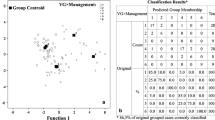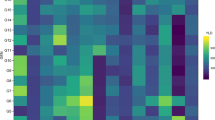Abstract
Thirty-six lentil varieties were evaluated under organic and conventional environment for three consecutive years in order to see whether the promising genetic material for an organic plant breeding program are different from those of a conventional system. The genetic material studied originated from various countries. In the conventional trial plots standard cultural practices (P mineral fertilization & pest control) were applied throughout the growing season, while in the organic ones no fertilizers or pest agrochemicals were applied. Significant regression, but of low value, between grain yield ranking and earliness or harvest index ranking was detected. Combined ANOVA indicated significant differences between genotypes, years, environments and genotype × environmental interactions (GEI). It was observed that under conventional management most of the genotypes had a higher yield compared to the organic one. The mean grain yield ranking of the genotypes in each of the environments revealed that some of the genotypes occupied the same ranking position at both the organic and the conventional environment (non-crossover GEI), while others exhibited a significant alteration in their ranking (crossover GEI) under the two environments. Crossover GEI and non-cross over GEI revealed two types of lentil varieties. Varieties with specific adaptation and varieties with broad adaptation. It was concluded that grain yield was in general higher when lentil varieties were grown under a conventional environment compared to the grain yield produced under an organic environment. Yet, there are lentil genotypes with a higher yielding ability under the organic management and therefore should be targeted by the breeder.





Similar content being viewed by others
Abbreviations
- P2O5 :
-
Phosphorus pentoxide
References
Anonymous (1991) Council regulation (EEC) no 2092/91 of 24 June 1991. Official Journal No L 198, 22.7.1991. European Economic Community, Brussels, Belgium
Baker RJ (1988) Tests for cross-over genotype–environment interaction for yield. Can J Plant Sci 51:457–461
Balyan S, Singh HS (1986) Characters association in lentil. LENS 13(1):l–3
Burger H, Schloen M, Schmidt W, Geiger HH (2008) Quantitative genetic studies on breeding maize for adaptation to organic farming. Euphytica. doi:10.1007/s10681-008-9723-4
Ceccarelli S (1996) Adaptation to low/high input cultivation. Euphytica 92:203–214
Donald CM (1962) In search of yield. J Aust Inst Agric Sci 28:171–178
Erskine W (1996) Seed size effects on lentil (Lens culinaris) yield potential and adaptation to temperature and rainfall in West Asia. J Agric Sci (Camb) 126:335–341
Erskine W (1997) Lessons for breeders from landraces of lentil. Euphytica 93:107–112
Erskine W, El Ashkar F (1993) Rainfall and temperature effects on lentil (Lens culinaris) seed yield in the Mediterranean environment. J Agric Sci (Camb) 121:347–354
Erskine W, Tufail M, Russell A, Tyagi MC, Rahman MM, Saxena MC (1994) Current and future strategies in breeding lentil for resistance to biotic and abiotic stresses. Euphytica 73:127–135
Hamdi A, Erskine W, Gate P (1991) Relationships among economic characters in lentil. Euphytica 57:109–116
Hellenic National Statistical Service (2005) http://www.statistics.gr
Jain HK (1971) New plant types in pulses. Indian Farming 21(8):9–10
Joshi N, Singh S, Singh I (2005) Variability and association studies in lentil. Indian J Pulses Res 18(2):144–146
Koparanis T, Bladenopoulos Κ, Koutsika-Sotiriou M (2006) Biological and conventional cultivation effect on agronomic behavior between six old and new barley (Hordeum vulgare L.) varieties and estimation of their yield potential. Agric Res 29(1):41–52 (In Greek, English summary)
Kumar R, Sharma SK, Malik BPS, Dahiya A, Sharma A (2002) Correlation studies in lentil (Lens culinaris Medik.). Ann Biol 18(2):121–123
Lammerts van Bueren ET, Struik PC, Jacobsen E (2002) Ecological concepts in organic farming and their consequences for an organic ideotype. Neth J Agric Sci 50:1–26
Lammerts van Bueren ET, Struik PC, Tiemens-Hulscher M, Jacobsen E (2003) Concepts of intrinsic value and integrity of plants in organic plant breeding and propagation. Crop Sci 43:1922–1929
Malhotra RS, Singh KB, Bhullar GS, Sethi SC (1971) Phenotypic stability in lentil. Indian J Genet Plant Breed 31:21–25
Muehlbauer FJ, Summerfield RJ, Kaiser WJ, Clement SL, Boerboom CM, Welsh-Maddux MM, Short RW (2002) Principals and practice of lentil production. http://arsserv0.tamu.edu/is/np/lentils/lentils.htm. Cited: 2 Jun 2002
Phillips SL, Wolfe MS (2005) Evolutionary plant breeding for low input systems. J Agric Sci 143:245–254
Przystalski, Büchse A, Osman A, Piepho HP, Krajewski P (2007) Α method to analyse differences in ranking between conventional and organic variety tests. In: Proceedings of the COST SUSVAR workshop on varietal characteristics of cereals in different growing systems with special emphasis on below ground traits, 29–31 May Velence, Hungary, 152 pp
Ryan MH, Derrick JW, Dann PR (2004) Grain mineral concentrations and yield of wheat grown under organic and conventional management. J Sci Food Agric 84:207–216
Saxena MC (1981) Agronomy of lentils. In: Webb C, Hawtin G (eds) Lentils. Common Wealth Agricultural Bureaux, Norwich, pp 111–129
Sekhon HS, Dhingra KK, Sandhu PS, Bhandari SC (1986) Effect of time of sowing, phosphorus and herbicides on the response to Rhizobium inoculation. Lens Newsl 13:11–15
Singh TP (1977) Harvest Index in lentil (Lens culinaris Medik). Euphytica 26:833–839
Singh KB, Singh S (1969) Genetic variability and interrelationships studies on yield and other quantitative characters in lentil (Lens culinaris Medik.). Indian J Agric Sci 39:733–741
Solanki IS (2006) Comparison of correlations and path coefficients under different environments in lentil (Lens culinaris Medik.). Crop Improv 33(1):70–73
Tyagi MC, Sharma B (1985) Association among economic traits in lentil. LENS 12(1):l0–12
Wolfe MS, Baresel JP, Desclaux D, Goldringer I, Hoad S, Kovacs G, Löschenberger F, Miedaner T, Østergård H, Lammerts van Bueren ET (2008) Developments in breeding cereals for organic agriculture. Euphytica. doi:10.1007/s10681-008-9690-9
Yadav SS, Phogat DS, Solanki IS, Tomer YS (2005) Character association and path coefficient analysis under two environments in lentil. Indian J Pulses Res 18(2):147–149
Zaman MW, Mian NAK, Rahman MM (1989) Variability and correlation studies in local germplasm in lentil in Bangladesh. LENS 16(1):17–19
Acknowledgments
Authors would like to acknowledge Dr. Costas Iliadis, director of Fodder Crops and Pastures Institute, for valuable advices during the experimental period. This work was supported by grants from the National Agriculture Research Foundation of Hellenic Ministry of Agriculture.
Author information
Authors and Affiliations
Corresponding author
Rights and permissions
About this article
Cite this article
Vlachostergios, D.N., Roupakias, D.G. Response to conventional and organic environment of thirty-six lentil (Lens culinaris Medik.) varieties. Euphytica 163, 449–457 (2008). https://doi.org/10.1007/s10681-008-9712-7
Received:
Accepted:
Published:
Issue Date:
DOI: https://doi.org/10.1007/s10681-008-9712-7




